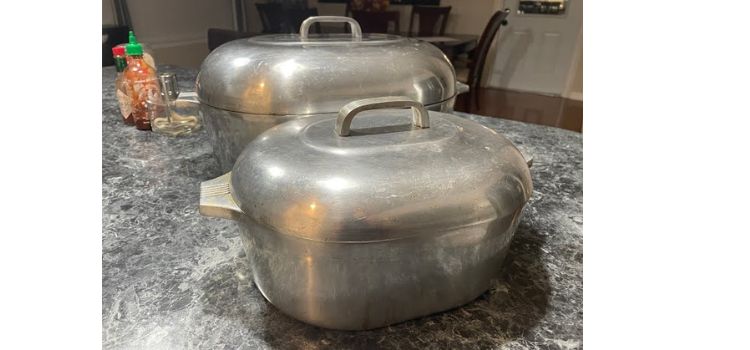As an Amazon Associate, I earn from qualifying purchases

Magnalite cookware has been a staple in kitchens for decades, renowned for its durability and exceptional heat conduction. Its iconic design and reliable performance have made it a favorite among home cooks and professional chefs alike.
However, as with many beloved kitchen tools, questions about its safety have emerged over the years. Understanding the origins, materials, and potential concerns associated with Magnalite cookware is crucial for anyone considering its use in their kitchen.
History of Magnalite Cookware
Magnalite cookware traces its roots back to the early 20th century, when it was first introduced by the Wagner Manufacturing Company. The brand quickly gained popularity due to its unique construction, which combined aluminum and magnesium to create a lightweight yet sturdy material.
This blend offered superior heat distribution, making it ideal for a variety of cooking methods. By the mid-20th century, Magnalite had become synonymous with quality cookware, often passed down through generations as a kitchen essential.
Materials Used in Magnalite Cookware
The defining feature of Magnalite cookware is its composition. Made primarily from a blend of aluminum and magnesium, this alloy was designed to provide the benefits of both materials. Aluminum is known for its excellent heat conductivity, allowing for even cooking and reducing the risk of hot spots. Magnesium adds strength and durability, ensuring that pots and pans can withstand frequent use and high temperatures.
While these materials contribute to the cookware’s performance, they also raise potential safety concerns. Aluminum, in particular, has been the subject of debate regarding its safety in cookware, prompting discussions about its impact on health.
Safety Concerns with Cookware
When it comes to cookware safety, the primary concern with Magnalite—and aluminum cookware in general—is the potential for aluminum to leach into food. This is more likely to occur when cooking acidic foods, which can react with the metal. Some studies have suggested a link between high aluminum intake and health issues, leading to cautionary advice from health professionals.
However, it’s important to note that much of the concern is based on excessive exposure, which is not typical in everyday cooking. The body’s ability to excrete aluminum effectively means that trace amounts from cookware are generally considered safe for most people.
Scientific Studies and Expert Opinions

Numerous studies have investigated the safety of aluminum cookware, with varying results. Some research suggests that while aluminum can leach into food, the levels are typically well below those considered harmful. The World Health Organization (WHO) and other health agencies have established guidelines for safe aluminum intake, and normal use of aluminum cookware is generally within these limits.
Experts often recommend using anodized aluminum cookware, which has a protective layer that reduces leaching. Although Magnalite cookware isn’t anodized, proper cooking techniques and maintenance can minimize risks.
Comparing Magnalite to Other Cookware Materials
When evaluating the safety of Magnalite cookware, it’s useful to compare it with other popular materials. Stainless steel, for example, is prized for its resistance to rust and non-reactive nature, making it a safe choice for all types of cooking. Cast iron offers excellent heat retention and can be seasoned to create a natural non-stick surface, though it requires careful maintenance to prevent rust.
Non-stick cookware, typically coated with polytetrafluoroethylene (PTFE), offers ease of use but has faced scrutiny over potential chemical release at high temperatures. Each material has its advantages and drawbacks, and choosing the right one often depends on individual cooking needs and safety preferences.
Tips for Safe Use of Magnalite Cookware
To ensure safe use of Magnalite cookware, consider the following tips:
- Avoid Cooking Acidic Foods: Limit cooking highly acidic foods, such as tomato sauce or citrus-based dishes, in Magnalite cookware to reduce the risk of aluminum leaching.
- Use Low to Medium Heat: Magnalite’s excellent heat conductivity means you can cook effectively at lower temperatures, reducing wear on the cookware and minimizing potential risks.
- Proper Cleaning and Maintenance: Hand wash Magnalite cookware with mild detergent and avoid using abrasive sponges or cleaners that could damage the surface.
- Regular Inspection: Check for signs of wear or damage, such as pitting or discoloration, and replace cookware as needed to maintain safety.
Conclusion
Magnalite cookware remains a beloved choice for many cooks due to its impressive heat conductivity and durability. While concerns about aluminum leaching exist, informed use and proper care can mitigate these risks.
By understanding the materials and adhering to safe cooking practices, you can continue to enjoy the benefits of Magnalite cookware. Whether you’re a long-time fan or new to this iconic brand, making informed decisions about your cookware can enhance your culinary experience and ensure safety in the kitchen.
FAQ
Is it safe to cook in Magnalite cookware?
Yes, it is generally safe to cook in Magnalite cookware when used properly. Although concerns about aluminum leaching exist, using low to medium heat and avoiding acidic foods can minimize risks. Proper maintenance and cleaning also help maintain safety and performance over time.
What is so special about Magnalite pots?
Magnalite pots are renowned for their exceptional heat conductivity and durability, thanks to their unique aluminum and magnesium alloy construction. The design ensures even cooking, reducing hot spots, and enhancing flavor. Their classic, robust design has made them a beloved choice for both amateur cooks and professional chefs.
What material is Magnalite made of?
Magnalite cookware is crafted from a blend of aluminum and magnesium alloy. This combination provides excellent heat distribution and strength, making the cookware both efficient and durable. The materials are chosen to enhance cooking performance while maintaining a lightweight, easy-to-handle design.
As an Amazon Associate, I earn from qualifying purchases